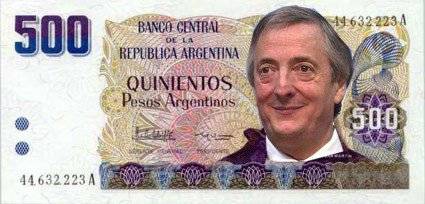
Evita’s visage replaces that of President Julio Argentino Roca (1880-86; 1898-1904), a military man whose so-called Campaña del Desierto is widely considered to have been a genocidal campaign against the Mapuche of Patagonia. Roca is a polarizing figure, whose equestrian statues in Buenos Aires and Bariloche (pictured above) are often defaced with graffiti.
Funny Money: An Argentine Tradition

In the mid-1990s, while working for another guidebook
publisher best not mentioned by name, I wrote a sidebar about the so-called “Menem Trucho” (“Bogus
Menem”), a pseudo-banknote glorifying then President Carlos Menem.
It was the work of Armando
Gostanián, a political hack who was then in charge of the Casa de la Moneda, Argentina’s
national mint. It also included the punning motto “1 Valor Que Estabilizó al
País,” mimicking the numerical value of a real banknote while suggesting that
Menem possessed “Bravery That Stabilized the Country” (which admittedly, had
been chaotic when he won the office in 1989).

Clarín used my piece to establish a parallel with
Argentina’s current vice-president Amado Boudou, presently
under investigation for influence peddling over contracts awarded for the
printing of 100-peso banknotes. The kicker is that the guitar-playing
vice-president has become the subject of his own photoshopped “Boudou Trucho.” Text
on the note says, among other things, “Banco Central de la Guitarrita
Argentina” (Central Bank of the Little Argentine Guitar). It’s only fair to add
that Clarín is an outspoken editorial critic of the administration of Cristina
Fernández de Kirchner.

At the same time, the government is due to decide whether a new 500-peso note will bear the image of Perón or former President Hipólito Yrigoyen, though the photoshoppers have suggested that the late President Néstor Kirchner might be the most suitable choice for a bill that, effectively, acknowledges the inflation that’s taken place under his government and his widow’s.
Argentine Trains: Off the Rails, So to Speak

Trains like El Gran Capitán, which until recently connected the capital with the northern city of Posadas, are by all accounts something to avoid (especially in summer, when the weather is brutally hot and humid). It’s theoretically possible to travel by rail from Constitución to Bariloche, but that requires crossing the Río Negro from Carmen de Patagones to Viedma and then waiting six days for the connection.
Yet the trains are full, and that’s because they’re cheap.
To quote Clarín, “According to the level of service, the bus can cost nine
times more than the train,” which is the only option for many poorer
Argentines. The train to Córdoba,
for instance, costs 30 pesos (about US$7), while the bus can cost 250 pesos
(roughly US$64). For that reason, the trains sell out early: “In high season,
it’s better to buy 90 days ahead of time – the rest of the year 15 should be
sufficient – and departures are few: the train departs only Monday and Friday.”
That’s why I discourage anybody but the truly determined
from taking long-distance trains in Argentina. My friends Darek
Przebieda and Analía Rupar of Eureka Travel recommend the Tren Patagónico from
Viedma to Bariloche but, even then, they have to admit that the 18-hour trip
averages only about 45 km per hour, and a comfortable sleeper bus would cover the
distance in half the time. For my part, I’ll stick with an excursion on Esquel’s
La
Trochita.
ENLACES/FUENTES:
http://southernconeguidebooks.blogspot.com.ar/
http://southernconeguidebooks.blogspot.com.ar/search/label/Argentina